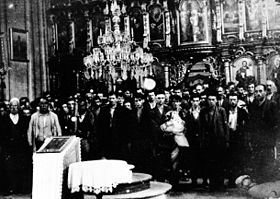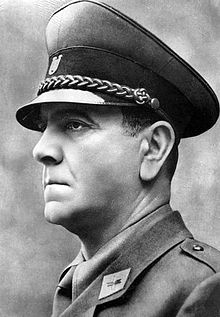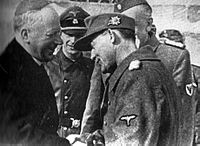- Catholic clergy involvement with the Ustaše
-
Catholic clergy involvement with the Ustaše covers the role of the Croatian Catholic Church in the Independent State of Croatia (NDH), a Nazi puppet state created on the territory of Axis-occupied Yugoslavia in 1941. The NDH was controlled by the Ustaše movement.
Contents
Creation and recognition
Main article: Catholic Church in CroatiaThe creation of the Independent State of Croatia was initially welcomed by the hierarchy of the Catholic Church and by many Catholic priests. Ante Pavelić, the head of the Ustaša, was anti-Serb and pro-Catholic, viewing Catholicism as an integral part of Croat culture.[1] Cornwell views the "ancient loyalties to the papacy going back thirteen hundred years" as one of the historical legacies that "underpinned the formation of the NDH" along with Catholic Croat resentment against Orthodox Serbs.[2]
For the Ustaša, "relations with the Vatican were as important as relations with Germany" because Vatican recognition was the key to widespread Croat support.[1] Ante Pavelić was received in a private papal audience in Rome in May 1941, just after becoming dictator of Croatia.[3] According to Michael Phayer, "after receiving a papal blessing in 1941, Ante Pavelić and his Ustaša lieutenants unleashed an unspeakable genocide in their new country".[4] However, Pius XII refused to cut diplomatic ties with the Ustaša regime and met Pavelić again in 1943.[4] Pius XII was criticized for his reception of Pavelić: an unattributed British Foreign Office memo on the subject described Pius XII as "the greatest moral coward of our age."[5] For their part, the Vatican hoped the Ustaša would defeat communism in Croatia and reconvert many of the 200,000 who had left the Catholic Church for the Serbian Orthodox Church since World War I.[1]
Archbishop Aloysius Stepinac was at the time of his appointment in 1934 the youngest Catholic bishop in the world.[6] He initially received very little guidance from the Vatican and was given great leeway in how to deal with the rise of the Ustaše regime.[6] His control over the lower bishops and clergy was not uniform.[6] Stepinac began attempting to publicly distance himself from the Ustaša in May 1941.[7] As the Ustaše murders "increased exponentially" in the summer and fall of 1941, Stepinac fell under "heavy criticism" for the church's collaboration, but was "not yet prepared to break with" the Ustaše.[8] Stepinac gave the Ustaše the "benefit of the doubt" and "decided on a limited response".[8]
Stepinac shared the hope for a Catholic Croatia and viewed the Yugoslav state as "the jail of the Croatian nation".[1] The Vatican was not as enthusiastic as Stepinac and did not formally recognize the Ustaša, instead sending Giuseppe Ramiro Marcone as an apostolic visitor.[1] Stepinac, who arranged the meeting between Pius XII and Pavelić, was satisfied with this step, viewing it as de facto recognition and Marcone as a nuncio in all but name.[1]
Role in Ustaše violence
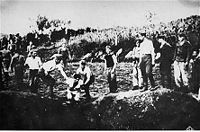 Execution of prisoners at the Jasenovac concentration camp, run by expelled [9] [10]Franciscan Miroslav Filipović[6][11]
Execution of prisoners at the Jasenovac concentration camp, run by expelled [9] [10]Franciscan Miroslav Filipović[6][11]
It is well-known that many Catholic clergy members participated directly or indirectly in Ustaša campaigns of violence, as is attested in the work of Corrado Zoli (Italian) and Evelyn Waugh (English).[12] The most notorious example is that of Franciscan Miroslav Filipović (eventually expelled), known as "the devil of Jasenovac" for running the Jasenovac concentration camp, where estimates of the number killed range between 49,600 and 600,000.[6][11][13] Ivan Šarić is believed to have been the "worst" of the Catholic bishops who supported the Ustaša; his diocesan newspaper wrote: "there is no limit to love. The movement of liberation of the world from the Jews is a movement for the renewal of human dignity. Omniscient and omnipotent God stands behind this movement".[7] Bishop Šarić also appropriated Jewish property for his own use.[7]
Some Catholic priests served in the personal bodyguard of Pavelić, including Ivan Guberina, a leader of the Croatian Catholic movement, a form of Catholic Action.[6] Another, Bozidas Bralo, was the chief of the security police in Sarajevo, who initiated many antisemitic actions.[6] In order to consolidate the Ustaša party power, much of the party work in Bosnia and Herzegovina Jure Francetić (an Ustaše Commissioner of this province), was put in the hands of Catholic priests.[14]
One Catholic priest, Mate Mugos wrote that clergy should put down the prayer book and take up the revolver.[6] Another, Dyonisy Juricev, wrote in the Novi list that to kill seven-year-olds was not a sin.[6] Phayer argues that "establishing the fact of genocide in Croatia prior to the Holocaust carries great historical weight for our study because Catholics were the perpetrators and not, as in Poland, the victims".[15]
Forced conversions
As Pavelić's government cracked down on the Orthodox Serbs, along with the Jewish, Muslim, and Protestant Germanic minorities, the Catholic clergy took steps to encourage Orthodox Serbs to convert to Roman Catholicism.[16] By July 14, 1941—"anticipating its selective conversion policy and eventual goal of genocide"—the Croatian Ministry of Justice instructed the Croatian episcopate that "priests or schoolmasters or, in a word, any of the intelligentsia—including rich Orthodox tradesmen and artisans" should not be admitted.[17] Those that were pre-rejected from the "coming program of enforced conversion" were deported and killed, although many that converted met the same fate.[18]
Croats appropriated many churches that were "vacated or requisitioned" from the Orthodox Serbs.[18] The Catholic episcopate and HKP, the Croatian branch of Catholic Action, a lay organization, were involved in the coordination and administration of these policies.[18]
1941 synod
Archbishop Stepinac called a synod of Croatian bishops in November 1941.[8] The synod appealed to Pavelić to treat Jews "as humanely as possible, considering that there were German troops in the country".[8] The Vatican replied with praise to Marcone with praise for what the synod had done for "citizens of Jewish origin", although Israeli historian Menachem Shelah demonstrates that the synod concerned itself only with converted Jews.[8] Pius XII personally praised the synod for "courage and decisiveness".[19] Shelach has written that,
A bishops' conference that met in Zagreb in November 1941 was not... prepared to denounce the forced conversion of Serbs that had taken place in the summer of 1941, let alone condemn the persecution and murder of Serbs and Jews. It was not until the middle of 1943 that Stepinac, Archbishop of Zagreb, publicly came out against the murder of Croatian Jews (most of whom had been killed by that time) the Serbs, and other nationalities. In the early stage, the Croatian massacres were explained as "teething troubles of a new regime" in Rome by Msgr Domenico Tardini of the Vatican state secretariat.)[20]
Dissenting clergy
A few prominent Catholic clergymembers objected to the Ustaša violence.[7] One of them was Aloysius Mišić, the bishop of Mostar.[7] Gregorij Rožman, the bishop of Ljubljana in Slovenia allowed Jews that had converted to Catholicism and fled from Croatia into his diocese to remain there, with assistance from Jesuit Pietro Tacchi Venturi in obtaining the permission of the Italian civil authorities[21].
Role of the Vatican
According to historian Michael Phayer, "it is impossible to believe that Stepinac and the Vatican did not know that the Ustasha murders amounted to genocide".[11] Cornwell considers the Catholic involvement important because of: "the Vatican's knowledge of the atrocities, Pacelli's failure to use his good offices to intervene, and the complicity it represented in the Final Solution being planned in northern Europe".[2]
Pius XII was a long-standing supported of Croat nationalism; he hosted a national pilgrimate to Rome in November 1939, for the cause of the canonization of Nicola Tavelic, and largely "confirmed the Ustashe perception of history".[16] In a meeting with Primate Stepinac, Pius XII reiterated the epithet of Pope Leo X, that the Croats were "the outpost of Christianity", a term which itself implied that the Orthodox Serbs were not true Christians.[16] Pius XII foretold to Stepinac that:
- "The hope of a better future seems to be smiling on you, a future in which the relations between Church and State in your country will be regulated in harmonious action to the advantage of both".[16]
Undersecretary of State Montini (later elected Pope Paul VI) was responsible for "day-to-day matters concerning Croatia and Poland". [19] He reported to Pius XII on a daily basis, and heard of the Ustaša atrocities in 1941.[19] In March 1942, Montini asked the Ustaša representative to the Vatican "Is it possible that these atrocities have taken place?", and responded that he would view such accusations with "considerable reserve" once the representative called them "lies and propaganda".[19] Montini's fellow Undersecretary Domenico Tardini told the Ustaša representative that the Vatican was willing to indulge the Ustaša regime because: "Croatia is a young state [...] Youngsters often err because of their age. It is therefore not surprising that Croatia also erred".[19]
Stepinac was summoned to Rome in April 1942, where he delivered a nine-page document detailing various misdeeds of Pavelić.[11] This document described the atrocities as "anomalies" that were either unknown or unauthorized by Pavelić himself; it is omitted from the ADSS.[11] However, by 1942 the Vatican "preferred to have Stepinac try to rein the fascists in rather than risk the effect that a papal denunciation would have on the unstable Croatian state".[11]
According to Eugene Tisserant, the future Dean of the College of Cardinals, "we have the list of all clergymen who participated in these atrocities and we shall punish them at the right time to cleanse our conscience of the stain with which they spotted us".[22] Pius XII was well-informed of the involvement of Croatian Catholic clergy with the Ustaša regime, but decided against condemning the regime or even taking action against the involved clergy, who had "joined in the slaughter", fearing that it would lead to schism in the Croatian church or undermine the formation of a future Croatian state.[23]
Phayer contrasts the Vatican's "limited and sketchy" knowledge of the genocide in Poland with "the Croatian case, in which both the nuncio and the head of the church, Bishop Alojzje Stepinac, were in continuous contact with the Holy See while the genocide was being committed".[15] Cardinal Secretary of State Maglione instructed nuncio Marcone that "if your eminence can find a suitable occasion, he should recommend in a discreet manner, that would not be interpreted as an official appeal, that moderation be employed with regard to Jews on Croatian territory. Your Eminence should see to it that [...] the impression of loyal cooperation with the civil authorities be always preserved".[24] According to Phayer, the Vatican "preferred to bring diplomatic pressure on the Ushtasha government instead of challenging the fascists publicly on the immorality of genocide".[21]
Pavelić audience
Pavelić visited Rome on May 18, 1941 to sign a treaty with Mussolini granting Italy control over several Croatian cities and districts on the Dalmatian coast.[25] While in Rome, he was granted a "devotional" audience with Pius XII.[25] Cornwell views this act as "de facto recognition by the Holy See" of the Independent State of Croatia.[25] Soon afterwards, Abbot Ramiro Marcone was appointed apostolic legate to Zagreb.[25]
Cornwell is unsure whether the Vatican was aware of the exact atrocities committed by the Ustaše by this point, but he noted "it was known from the very beginning that Pavelic was a totalitarian dictator, a puppet of Hitler and Mussolini, that he had passed a series of viciously racist and anti-Semitic laws, and that he was bent on enforced conversions from Orthodox to Catholic Christianity".[25]
Aftermath
Vatican "ratlines"
According to Phayer, "at the end of the war, the leaders of the Ustasha movement, including its clerical supporters such as Bishop Saric, fled the country, taking gold looted from massacred Jews and Serbs with them to Rome".[26]
Pope Pius XII protected Ante Pavelić after World War II, gave him "refuge in the Vatican properties in Rome", and assisted in his flight to South America; Pavelić and Pius XII shared the goal of a Catholic state in the Balkans and were unified in their opposition to the rising Communist state under Tito.[27] Pius XII also believed that Pavelić and other war criminals could not get a fair trial in Yugoslavia.[28] After arriving in Rome in 1946, Pavelić used the Vatican "ratline" to reach Argentina in 1948, along with other Ustaša,[27] Russian, Yugoslav, Italian, and American spies and agents all tried to apprehend Pavelić in Rome but the Vatican refused all cooperation and vigorously defended its extraterritorial status.[3] Pavelić was never captured or tried for his crimes.[27]
According to Phayer, "the Vatican's motivation for harboring Pavelić grew in lockstep with its apprehension about Tito's treatment of the church".[29]
Dozens of Croatian refugees and war criminals were housed in the Pontifical Croatian College of St. Jerome in Rome.[29] Intelligence reports differed over the location of Pavelić himself.[29] Counter Intelligence Corps agent William Gowen (the son of Franklin Gowen, a US diplomat in the Vatican) was one of those tasked with finding Pavelić; although the CIC hoped the relationship would reveal Pavelić's location, eventually the reverse occurred and the Vatican convinced the US to back off.[30] By the Spring of 1947, the Vatican was putting intense diplomatic pressure on the US and the UK not to extradite Ustaša war criminals to Yugoslavia.[31]
Special Agent Gowen warned in 1947 that, due to Pavelić's record of opposing the Orthodox Church as well as Communism, his "contacts are so high and his present position is so compromising to the Vatican, that any extradition of the subject would be a staggering blow to the Roman Catholic Church".[32] The feared embarrassment of the Church was not due to Pavelić's use of the Vatican "ratline" (which Pavelić at this point, still hoping to return, had not yet committed to using), but rather due to the facts the Vatican believed would be revealed in Pavelić's eventual trial.[33]
Ustaše gold
The Ustaši hiding in Pontifical Croatian College of St. Jerome (the Croatian Seminary near the Vatican) brought a large amount of looted gold with them; this was latter moved to other Vatican extraterritorial property and/or the Vatican Bank.[4][34] Although this gold would be worth hundreds of thousands of 2008 US dollars, it constituted only a small percentage of the gold looted during World War II, mostly by the Nazis.[34] According to Phayer, "top Vatican personnel would have known the whereabouts of the gold".[34]
Surviving victims of the Ustaše and their next of kin living in California brought a class action lawsuit against the Vatican bank and others in US federal court, Alperin v. Vatican Bank.[34] Specifically, the Vatican bank was charged with laundering and convering "the Ustaša treasury, making deposits in Europe and North and South American, [and] distributing the funds to exiled Ustaša leaders including Pavelić".[35] A principal piece of evidence against the Vatican is the "Bigelow dispatch", an October 16, 1946 dispatch from Emerson Bigelow in Rome to Harold Glasser, the director of monetary research for the U.S. Treasury Department.[35] Former OSS agent William Gowen has also given deposition as an expert witness that in 1946 Colonel Ivan Babić transported 10 truckloads of gold from Switzerland to the Pontifical College.[36] All charges have been dismissed.[37]
Relations with SFR Yugoslavia
According to Phayer, "even before the end of the war, Tito had begun to settle the score with the Ustaša, which meant with the Catholic Church as well because of the close relations between the two".[38] Partisans of Tito retaliated against the Catholic clergy for their perceived or actual collaboration with the Ustaše; by February 1945, at least fourteen priests had been killed; by March 1945, as many as 160 priests; by the end of the year, 270 priests.[39] According to Catholic novelist Evelyn Waugh (who visited Croatia after the war), "the task of the partisans was made easier in that the clergy as a whole had undoubtedly compromised the church by tolerating the pro-Axis Ustashis, if not actively collaborating with them".[39] Franciscans in particularly were singled out for partisan attacks and fifteen Franciscan monasteries were destroyed.[39]
In this sense, the situation was a microcosm of the general situation of the Vatican in Communist Eastern Europe.[40] Pius XII sent American bishop Joseph Patrick Hurley as his envoy to Tito (as Hurley carried the title of "regent", this was a step below official diplomatic recognition).[39] Tito requested to Hurley that Archbishop Stepinac be recalled to Rome; the pope deferred to Stepinac himself, who chose to stay.[41]
Post-war trials
 Pius XII created Aloysius Stepinac (pictured, right, with Pavelić) cardinal after he was convicted of collaborating with the Ustaša.[42]
Pius XII created Aloysius Stepinac (pictured, right, with Pavelić) cardinal after he was convicted of collaborating with the Ustaša.[42]
- Rožman
Bishop Gregorij Rožman of Ljubljana was the first bishop tried for "collaboration" in Yugoslavia, in absentia, by the military court in August 1946. The trial was repealed in 2007 by the Slovene Supreme Court[43] The British occupational authorities had recommended that he "be arrested and interned as a Ustaša collaborator".[41] Phayer views his trial as a "warm-up for proceedings against Stepinac", and after Rožman was convicted, Stepinac was arrested.[41] (Rožman found safe haven in the United States, where he died.)
- Stepinac
Archbishop Aloysius Stepinac was indicted on the charges of supporting the Ustaše government, urging forced conversions of Orthodox Serbs, and encouraging Ustaše resistance in Yugoslavia.[41] Phayer argues that Stepinac (who remained silent during his trial) could have defended himself from the charge of supporting forced conversions, but not the other two.[42] Stepinac was found guilty and sentenced to 16 years imprisonment.[41] He served 5 years in the Lepoglava prison before the sentence was commuted to home arrest.
Pius XII elevated Stepinac to the cardinalate in 1952.[44] Although Phayer agrees in part with criticisms of Stepinac conviction as a "show trial", he states "the charge that he supported the Ustaša regime was, of course, true, as everyone knew",[42] and that "if Stepinac had responded to the charges against him, his defense would have inevitably unraveled, exposing the Vatican's support of the genocidal Pavelić".[45] Most incriminatingly, Stepinac had allowed the state papers of the Ustaše to be stored in his episcopal residence, papers that would be crucial to the Ustaše in retaking control of the country and which contained volumes of incriminating information against Ustaše war criminals.[42]
Stepinac was transferred back home to the village of Krašić in 1953 and died in his residence seven years later. In 1998, Pope John Paul II beatified him.
See also
Notes
- ^ a b c d e f Phayer, 2000, pg. 32.
- ^ a b Cornwell, 1999, pg. 249
- ^ a b Phayer, 2008, pg. 221
- ^ a b c Phayer, 2008, pg. 219.
- ^ Mark Aarons and John Loftus Unholy Trinity pgs. 71–2
- ^ a b c d e f g h i Phayer, 2000, pg. 34
- ^ a b c d e Phayer, 2000, pg. 35
- ^ a b c d e Phayer, 2000, p. 36.
- ^ [1]
- ^ "Goldhagen v. Pius XII". 2007.
- ^ a b c d e f Phayer, 2000, pg. 38
- ^ Phayer, 2000, pgs. 34-5
- ^ [2] Yad Vashem
- ^ War and Revolution in Yugoslavia, 1941-1945: Occupation and Collaboration by Jozo Tomasevich, published by Stanford University Press, 2001 ISBN 0804736154, 9780804736152 (page 490)
- ^ a b Phayer, 2000, pg. 30
- ^ a b c d Cornwell, 1999, pg. 250
- ^ Cornwell, 1999, pgs. 250-1
- ^ a b c Cornwell, 1999, pg. 251
- ^ a b c d e Phayer, 2000, p. 37.
- ^ Encyclopedia of the Holocaust vol 1., pg. 328
- ^ a b Phayer, 2000, pg. 39
- ^ Phayer, 2008, pg. 225
- ^ Phayer, 2008, pgs. 9-16
- ^ Phayer, 2000, pgs. 36-7
- ^ a b c d e Cornwell, 1999, p. 252.
- ^ Phayer, 2000, pg. 40
- ^ a b c Phayer, 2008, pg. 220
- ^ Phayer, 2008, pg. 226
- ^ a b c Phayer, 2008, pg. 222
- ^ Phayer, 2008, pgs. 222-3
- ^ Phayer, 2008, pg. 227
- ^ Phayer, 2008, pg. 28
- ^ Phayer, 2008, pgs. 228-9
- ^ a b c d Phayer, 2008, p. 208.
- ^ a b Phayer, 2008, pg. 209.
- ^ Phayer, 2008, pg. 210
- ^ Sud odbio tužbu preživjelih iz holokausta u NDH protiv Vatikanske banke
- ^ Phayer, 2008, pg. 135
- ^ a b c d Phayer, 2008, pg. 148
- ^ Phayer, 2008, pg. 136
- ^ a b c d e Phayer, 2008, pg. 150
- ^ a b c d Phayer, 2008, pg. 151
- ^ http://www.rtvslo.si/slovenija/sodba-proti-rozmanu-razveljavljena/77653
- ^ Phayer, 2008, pgs. 10-15, 147, 150
- ^ Phayer, 2008, pg. 152
References
- Cornwell, John. 1999. Hitler's Pope: The Secret History of Pius XII. Viking. ISBN 0-670-87620-8
- Falconi, Carlo. Bernard Wall (trans.). 1970. The Silence of Pius XII. Boston: Little, Brown, and Company.
- Phayer, Michael. 2000. The Catholic Church and the Holocaust, 1930–1965. Indianapolis: Indiana University Press. ISBN 0-253-33725-9.
- Phayer, Michael. 2008. Pius XII, The Holocaust, and the Cold War. Indianapolis: Indiana University Press. ISBN 978-0-253-34930-9.
Pope Pius XII (1939–1958) Biography Early life · Nunciature · US visit · Election · Late years · Illness and death · Testament · Cause for Canonization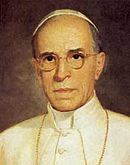
World War II The Holocaust (statements on) (conversion of Jews during) · Roman razzia · Occupied dioceses · Ustaše involvement · Jewish orphans · Pontifical Relief Commission · 1942 Christmas address · Alleged kidnapping plot · Yad Vashem · Bombing of RomeForeign relations Nazi Germany (Reichskonkordat) · Post-World War II · "Ratlines" · Persecutions · China · Eastern Europe · Poland · RussiaTheology Social teachings · Mariology · Judaism · Liturgy · Eastern Canon Law · Canonizations · Beatifications · Fátima and BalasarWritings Appointments Advisers Bibliography Categories:- Nazism
- Independent State of Croatia
- History of Catholicism in Europe
- The Holocaust in Croatia
- Pope Pius XII and World War II
- Pope Pius XII and the Holocaust
Wikimedia Foundation. 2010.

